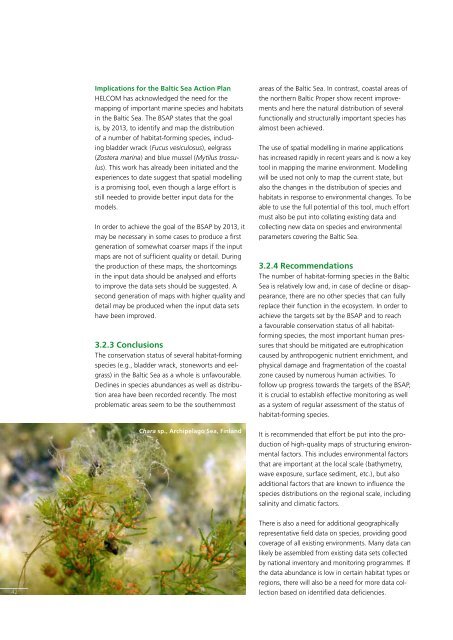BSEP116B Biodiversity in the Baltic Sea - Helcom
BSEP116B Biodiversity in the Baltic Sea - Helcom
BSEP116B Biodiversity in the Baltic Sea - Helcom
Create successful ePaper yourself
Turn your PDF publications into a flip-book with our unique Google optimized e-Paper software.
Implications for <strong>the</strong> <strong>Baltic</strong> <strong>Sea</strong> Action Plan<br />
HELCOM has acknowledged <strong>the</strong> need for <strong>the</strong><br />
mapp<strong>in</strong>g of important mar<strong>in</strong>e species and habitats<br />
<strong>in</strong> <strong>the</strong> <strong>Baltic</strong> <strong>Sea</strong>. The BSAP states that <strong>the</strong> goal<br />
is, by 2013, to identify and map <strong>the</strong> distribution<br />
of a number of habitat-form<strong>in</strong>g species, <strong>in</strong>clud<strong>in</strong>g<br />
bladder wrack (Fucus vesiculosus), eelgrass<br />
(Zostera mar<strong>in</strong>a) and blue mussel (Mytilus trossulus).<br />
This work has already been <strong>in</strong>itiated and <strong>the</strong><br />
experiences to date suggest that spatial modell<strong>in</strong>g<br />
is a promis<strong>in</strong>g tool, even though a large effort is<br />
still needed to provide better <strong>in</strong>put data for <strong>the</strong><br />
models.<br />
In order to achieve <strong>the</strong> goal of <strong>the</strong> BSAP by 2013, it<br />
may be necessary <strong>in</strong> some cases to produce a first<br />
generation of somewhat coarser maps if <strong>the</strong> <strong>in</strong>put<br />
maps are not of sufficient quality or detail. Dur<strong>in</strong>g<br />
<strong>the</strong> production of <strong>the</strong>se maps, <strong>the</strong> shortcom<strong>in</strong>gs<br />
<strong>in</strong> <strong>the</strong> <strong>in</strong>put data should be analysed and efforts<br />
to improve <strong>the</strong> data sets should be suggested. A<br />
second generation of maps with higher quality and<br />
detail may be produced when <strong>the</strong> <strong>in</strong>put data sets<br />
have been improved.<br />
3.2.3 Conclusions<br />
The conservation status of several habitat-form<strong>in</strong>g<br />
species (e.g., bladder wrack, stoneworts and eelgrass)<br />
<strong>in</strong> <strong>the</strong> <strong>Baltic</strong> <strong>Sea</strong> as a whole is unfavourable.<br />
Decl<strong>in</strong>es <strong>in</strong> species abundances as well as distribution<br />
area have been recorded recently. The most<br />
problematic areas seem to be <strong>the</strong> sou<strong>the</strong>rnmost<br />
Chara sp., Archipelago <strong>Sea</strong>, F<strong>in</strong>land<br />
areas of <strong>the</strong> <strong>Baltic</strong> <strong>Sea</strong>. In contrast, coastal areas of<br />
<strong>the</strong> nor<strong>the</strong>rn <strong>Baltic</strong> Proper show recent improvements<br />
and here <strong>the</strong> natural distribution of several<br />
functionally and structurally important species has<br />
almost been achieved.<br />
The use of spatial modell<strong>in</strong>g <strong>in</strong> mar<strong>in</strong>e applications<br />
has <strong>in</strong>creased rapidly <strong>in</strong> recent years and is now a key<br />
tool <strong>in</strong> mapp<strong>in</strong>g <strong>the</strong> mar<strong>in</strong>e environment. Modell<strong>in</strong>g<br />
will be used not only to map <strong>the</strong> current state, but<br />
also <strong>the</strong> changes <strong>in</strong> <strong>the</strong> distribution of species and<br />
habitats <strong>in</strong> response to environmental changes. To be<br />
able to use <strong>the</strong> full potential of this tool, much effort<br />
must also be put <strong>in</strong>to collat<strong>in</strong>g exist<strong>in</strong>g data and<br />
collect<strong>in</strong>g new data on species and environmental<br />
parameters cover<strong>in</strong>g <strong>the</strong> <strong>Baltic</strong> <strong>Sea</strong>.<br />
3.2.4 Recommendations<br />
The number of habitat-form<strong>in</strong>g species <strong>in</strong> <strong>the</strong> <strong>Baltic</strong><br />
<strong>Sea</strong> is relatively low and, <strong>in</strong> case of decl<strong>in</strong>e or disappearance,<br />
<strong>the</strong>re are no o<strong>the</strong>r species that can fully<br />
replace <strong>the</strong>ir function <strong>in</strong> <strong>the</strong> ecosystem. In order to<br />
achieve <strong>the</strong> targets set by <strong>the</strong> BSAP and to reach<br />
a favourable conservation status of all habitatform<strong>in</strong>g<br />
species, <strong>the</strong> most important human pressures<br />
that should be mitigated are eutrophication<br />
caused by anthropogenic nutrient enrichment, and<br />
physical damage and fragmentation of <strong>the</strong> coastal<br />
zone caused by numerous human activities. To<br />
follow up progress towards <strong>the</strong> targets of <strong>the</strong> BSAP,<br />
it is crucial to establish effective monitor<strong>in</strong>g as well<br />
as a system of regular assessment of <strong>the</strong> status of<br />
habitat-form<strong>in</strong>g species.<br />
It is recommended that effort be put <strong>in</strong>to <strong>the</strong> production<br />
of high-quality maps of structur<strong>in</strong>g environmental<br />
factors. This <strong>in</strong>cludes environmental factors<br />
that are important at <strong>the</strong> local scale (bathymetry,<br />
wave exposure, surface sediment, etc.), but also<br />
additional factors that are known to <strong>in</strong>fluence <strong>the</strong><br />
species distributions on <strong>the</strong> regional scale, <strong>in</strong>clud<strong>in</strong>g<br />
sal<strong>in</strong>ity and climatic factors.<br />
42<br />
There is also a need for additional geographically<br />
representative field data on species, provid<strong>in</strong>g good<br />
coverage of all exist<strong>in</strong>g environments. Many data can<br />
likely be assembled from exist<strong>in</strong>g data sets collected<br />
by national <strong>in</strong>ventory and monitor<strong>in</strong>g programmes. If<br />
<strong>the</strong> data abundance is low <strong>in</strong> certa<strong>in</strong> habitat types or<br />
regions, <strong>the</strong>re will also be a need for more data collection<br />
based on identified data deficiencies.

















